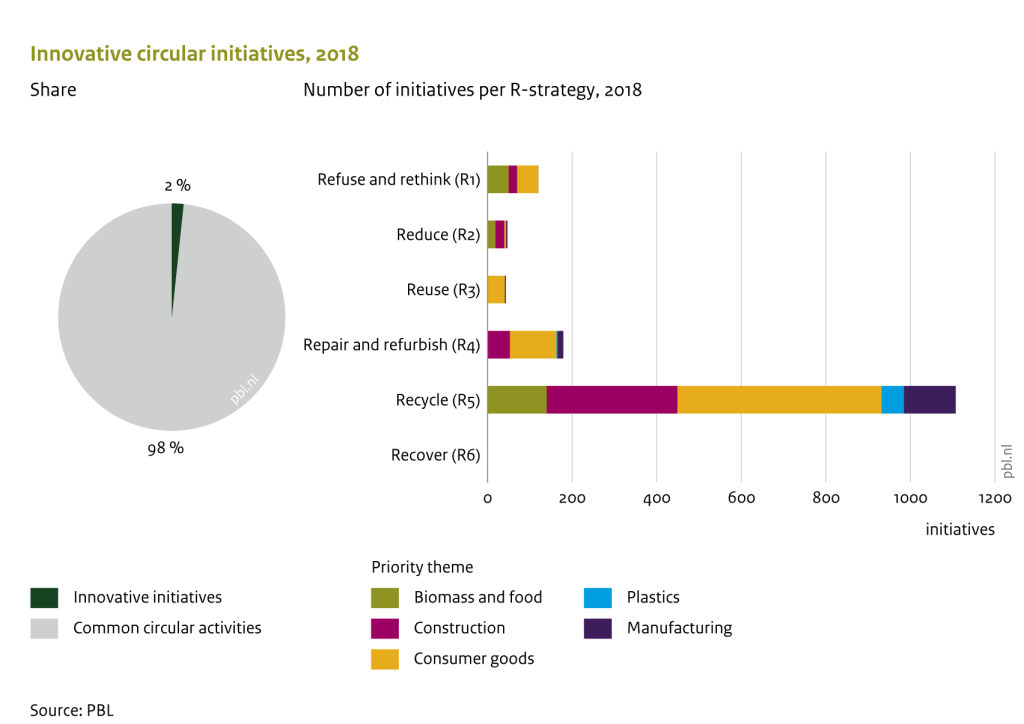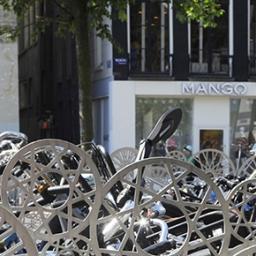The Netherlands has 85,000 circular activities, but new initiatives are struggling to break through
The Dutch economy has around 85,000 circular activities that employ around 420,000 people (4% of all jobs). While this shows that circularity has gained a foothold in the Dutch economy, the transition towards a circular economy is not without challenges. The Netherlands, currently, has 1,500 innovative initiatives. These initiatives are slow in gaining popularity, due to people’s persisting old habits, insufficient pricing of environmental pollution and conflicting rules and regulations. To drastically reduce the use of natural resources, government authorities could accelerate the transition towards a circular economy by focusing not only on recycling, but also and more so on repairing, sharing and leasing products as well as on circular product design.
These are the main conclusions in Outline of the Circular Economy, a summary report by PBL Netherlands Environmental Assessment Agency. PBL’s inventory is the first to outline all the circular activities within the Dutch economy. The inventory provides information that may also be of interest to other countries, as it shows the main characteristics of circular activities, analyses the barriers to achieving a circular economy and points to opportunities and possible steps for government and the business community to accelerate the transition.
Innovation is crucial
A large number of circular activities have been around for a long time, such as bicycle mechanics, auto repair shops, waste management facilities and second-hand shops. Many governments, in the EU and elsewhere in the world, have committed to making the transition towards a circular economy. To meet this objective, new and innovative methods are crucially important for radically improving the efficiency of resource use.
Currently, there are around 1,500 innovative initiatives in the Netherlands. These initiatives predominately focus on new techniques of recycling, such as bottles made of recycled plastics, toys made from bioplastics based on sugarcane residues, and rugs made from recycled polyester. There are, however, far fewer innovative initiatives outside the area of recycling—although those could potentially save far more on resources. These include initiatives that extend product lifespan through innovative design, such as the modular designs by Fairphone and modular headphones which allow parts to be renewed, and moveable modular houses. Furthermore, there are not many innovative business models yet, such as subscriptions to bicycle use and washing machines, and sharing platforms (e.g. Peerby and Snappcar).
The transition will not accelerate by itself
Circular initiatives are often struggling to break through, mainly due to the relatively low price of resources and products. Negative environmental impacts caused by the production or consumption of products are often not fully incorporated in resource and product prices, which does not encourage producers to invest in a more efficient use of natural resources.

In addition to the relatively low prices, there are also other barriers. Official standards, such as certification requirements, are not always fully in line with circular products. In addition, second-hand products and parts often have a rather negative reputation. And, in many instances, investors are unfamiliar with circularity. Addressing these types of barriers calls for stimulation in many areas of the circular economy and learning from successful initiatives, as well as collaboration and public support.
Recommendations
In many countries, governments are looking for ways to change their economy into one that is circular, or to improve the level of resource efficiency (e.g. see the EU programme ‘Closing the loop’ or the World Circular Economy Forum). Government authorities could stimulate innovation in numerous ways. In doing so, they could look to other circular possibilities besides recycling, such as reuse, repair services and facilitation, as well as other services. Examples of policy instruments include the development of circular procurement, extended producer responsibility (EPR) and subsidy schemes aimed at activities that would promote these forms of circularity. Furthermore, so-called innovation deals can be used for starting joint circular initiatives, involving initiators, permit issuing bodies and municipalities. Such collaborations would also help to address the negative impact of certain regulations and human habits, and may contribute to creating public support for the transition towards a circular economy.
A circular economy centres around the efficient use of resources. This produces environmental benefits; for example, because fewer new materials such as plastics and metal are needed, greenhouse gas emissions are reduced, biodiversity loss diminishes, and soil, water and air pollution decreases. A circular economy also reduces the risks to security of supply of, for instance, rare earth metals (required in the production of wind turbines, electric vehicles and mobile phones) and phosphates, which are crucial in biomass and food production.
